九年级英语Unit13Wearetryingtosavetheearth!教案
九年级英语unit13教案
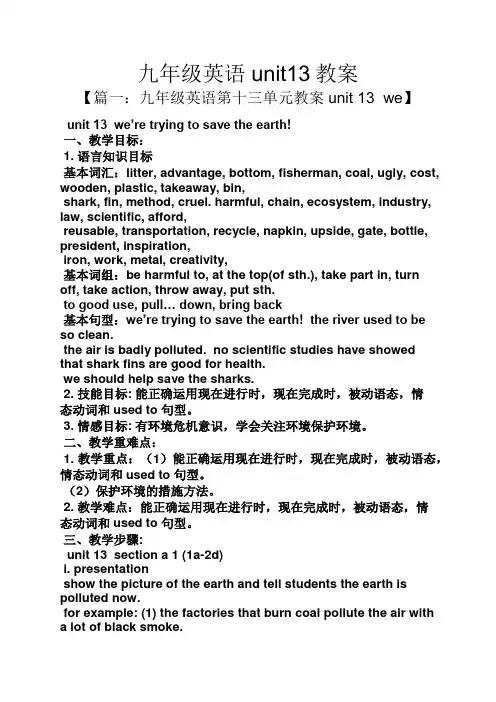
九年级英语unit13教案【篇一:九年级英语第十三单元教案unit 13 we】unit 13 we’re trying to save the earth!一、教学目标:1. 语言知识目标基本词汇:litter, advantage, bottom, fisherman, coal, ugly, cost, wooden, plastic, takeaway, bin,shark, fin, method, cruel. harmful, chain, ecosystem, industry, law, scientific, afford,reusable, transportation, recycle, napkin, upside, gate, bottle, president, inspiration,iron, work, metal, creativity,基本词组:be harmful to, at the top(of sth.), take part in, turn off, take action, throw away, put sth.to good use, pull… down, bring back基本句型:we’re trying to save the earth! the river used to beso clean.the air is badly polluted. no scientific studies have showedthat shark fins are good for health.we should help save the sharks.2. 技能目标: 能正确运用现在进行时,现在完成时,被动语态,情态动词和used to 句型。
3. 情感目标: 有环境危机意识,学会关注环境保护环境。
二、教学重难点:1. 教学重点:(1)能正确运用现在进行时,现在完成时,被动语态,情态动词和used to 句型。
人教版九年级英语Unit 13 We're trying to save the earth! 全单元教案
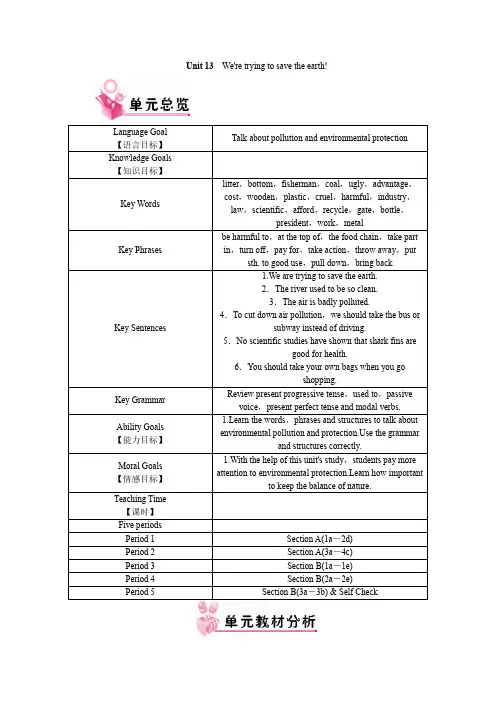
Unit 13We're trying to save the earth!本单元围绕环境保护的话题,并用主题图片表现噪音污染、空气污染、水污染等内容,目的是为了让学生对环境的破坏有一个直观的认识,从而激发学生强烈的社会责任感和对未来发展的思考。
Section A的重点是让学生掌握与环境污染和环境保护相关的词汇和句型,同时引导学生关爱动物、保护环境。
教学难点是让学生学会正确使用连词和结合生活实际讲述如何保护环境。
Section B在Section A所学的基础上,进一步谈论如何保护环境。
教学重点是让学生了解环境保护的方式,并落实到积极的行动当中,同时还有阅读策略和写作技巧的训练。
教学难点是让学生在阅读2a文章之后,根据所给词根找出衍生出的不同词汇,并理解前缀和后缀的不同用法。
The First Period—Section A(1a-2d)Teaching Important Points【教学重点】Key words & phrases:litter,bottom,fisherman,coal,ugly,advantage,cost,wooden,plasticnoise pollution,air pollution,water pollution,be full of,play a part in,turn…into,cut down air pollutionKey sentences:1.Even the bottom of the river was full of rubbish.2.It used to be so clean.3.Everyone in this town should play a part in cleaning it up.4.The air is badly polluted because there are more cars on the road these days.5.The air has become really polluted around here.6.We're trying to save the earth.Key structure:should+do;used to+do;have/has+done;be+done;be+doinge.g.Everyone should help to clean up the river.The air has become really polluted.I used to be able to see stars in the sky.The air is badly polluted.Teaching Difficult Points【教学难点】★Practice the structures to talk about pollution and environmental protection.Teaching Aids【教学工具】A tape recorder,CAI or multimedia courseware.Teaching Steps【教学过程】★Step 1Leading in【新课导入】1.Greeting2.Discussion and reviewDiscuss with the students,like this:T:What kinds of pollution are there these days?S:…T:What causes the pollution?S:…3.Review the words and expressions about the topic.★Step 2Cooperative inquiry【合作探究】1.Finish the task in 1a①Show pictures or play videos about pollution and talk about the pollution.②Read these phrases in 1a.Look at the pictures in 1a and say what they see in the pictures.Write down the words and add more words.③Ask students to say out their words in each kind of pollution.2.Finish the task in 1b①Read the instructions.Get the students to read the contents in the chart and think of what they will fill in the blanks.②Play the recording for the first time.Students listen and fill in the words.③Play the recording a second time.Ask them to check the answers.Then ask the questions.Students answer with full sentences.④Ask more questions to help students learn more details.Then play the recording for the students to role-pay the conversation.3.Finish the task in 1c①Show the key words of the conversation.Ask students to retell the contents in the chart.Like this:What:dirty;bottom,rubbish;fishWhy:littering,putting wasteHow:write to,close down;help to clean up②Read aloud the model dialogue in 1c.Then in pairs,do the oral practice with more words.③Ask two pairs to perform in class.4.Finish the tasks in 2a-2b①Use PPT or pictures to show the four kinds of pollution.Get the groups of students to havea competition to say words about the pollution one by one.land pollution:…air pollution:…noise pollution:…water pollution:…②Get the students to write down these words in their notebooks.③Play the recording for the first time.Students listen and circle the kinds of pollution.Check answers with the class.④Read the sentences in 2b.Predict the contents they will fill in.Play the recording.Students listen and complete the sentences.⑤Play the recording again.Check the answers with the whole class.5.Finish the task in 2c①Read the sample conversation in 2c.Then Read the listening materials and discuss in pairs what causes the two kinds of pollution.②Students work in pairs,making dialogues.③Ask three pairs to role-play their conversations to the class.6.Finish the task in 2d①Talk about the picture in 2d.Ask:What are your ideas for solving the air pollution/waste pollution problem?Present the new words in the conversation.Such as,coal,advantage,wooden,plastic,takeaway,bin,…②Read the conversation in 2d quickly.Find out the problems about environmental pollution in the dialogue.③Read the conversation again.Ask the students to find the ways to solve the problems of air and waste pollution.④Read aloud the conversation by the recording.⑤Learn the useful expressions:What are your ideas for doing…To cut down air pollution,we should…So together,our actions can make a difference and…⑥Role-play or read the conversation in pairs until fluently.★Step 3Homework1.What are your ideas for solving the waste pollution problem?2.Write the words about the four kinds of pollution.3.Translate the following sentences into English.(1)我们正在想办法拯救地球。
人教版英语九年级全册Unit13Wearetryingtosavetheearth课优秀教学案例
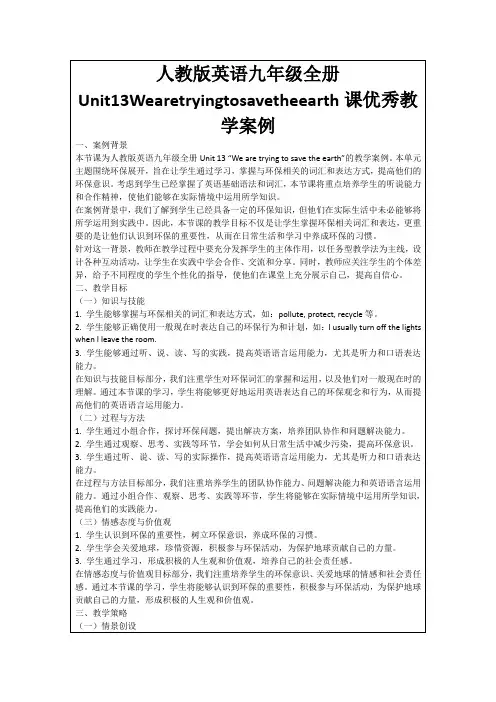
3.小组合作:教师将学生分成小组,让他们在小组内进行讨论、合作和实践。这种小组合作的形式,不仅培养了学生的团队协作能力和沟通能力,而且还提高了他们的实践能力,使他们在合作中发现问题、解决问题,提高了学习的实效性。
二、教学目标
(一)知识与技能
1.学生能够掌握与环保相关的词汇和表达方式,如:pollute, protect, recycle等。
2.学生能够正确使用一般现在时表达自己的环保行为和计划,如:I usually turn off the lights when I leave the room.
3.学生能够通过听、说、读、写的实践,提高英语语言运用能力,尤其是听力和口语表达能力。
2.教师设计各种小组活动,如共同完成任务、一起解决问题等,让学生在实践中学会合作、交流和分享,提高他们的实践能力。
3.教师对小组合作的过程进行观察和评价,及时给予反馈和建议,帮助学生不断提高团队合作的效果。
在小组合作部分,我们注重培养学生的团队协作能力、沟通能力和实践能力。通过设计各种小组活动,让学生在实践中学会合作、交流和分享,提高他们的实践能力。同时,教师对小组合作的过程进行观察和评价,及时给予反馈和建议,帮助学生不断提高团队合作的效果。
人教版英语九年级全册Unit13Wearetryingtosavetheearth课优秀教学案例
一、案例背景
本节课为人教版英语九年级全册Unit 13 “We are trying to save the earth”的教学案例。本单元主题围绕环保展开,旨在让学生通过学习,掌握与环保相关的词汇和表达方式,提高他们的环保意识。考虑到学生已经掌握了英语基础语法和词汇,本节课将重点培养学生的听说能力和合作精神,使他们能够在实际情境中运用所学知识。
人教版九年级英语下册Unit 13 We’re trying to save the earth!S
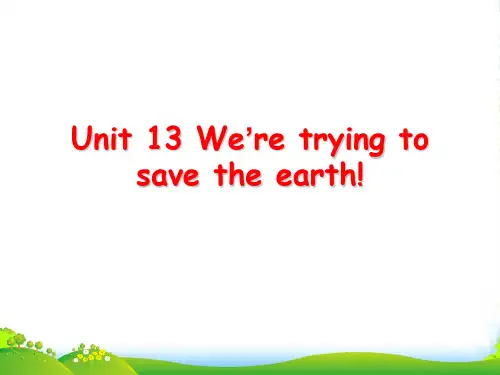
2.It's good for hetrlth and it doesn’t cost anything!它有利于信康,并且它不花费任何东
西!(教材第98页) be good for意为“对……有益”,反义词组be bad for意为“对……有害”。 辨析:be good for,be good at与be good with
【中考链接2】
1. (2014山东威海中考模拟) Why don't you__A _your
friends to the party? I want to meet them.
A bring
B. brings
C.leaves
D Mr Li. I A my
Unit 13 We’re trying to save the earth!
Section A 课堂精讲
【语法点精讲】
1.(1)We're trying to save the earth!我们正在 竭力拯救地球!
(2)People are throwing litter into the river.人们 正在把垃圾扔进河里。
(2) 表示现阶段正在进行的动作或存在的状态。 如: They are studying hard this term. 他们这个学期学习一直很努力。 (3)come,go,leave,arrive,start等动词用现在 进行时表示将来。 如:The bus is coming soon. 车不久就会来了。 (4)在由while(当……时候)引导的状语从句中,动
English homework at home.
-Don’t forget it to school tomorrow.
新人教版九年级英语下册《Unit13We’retryingtosavetheearth》教案
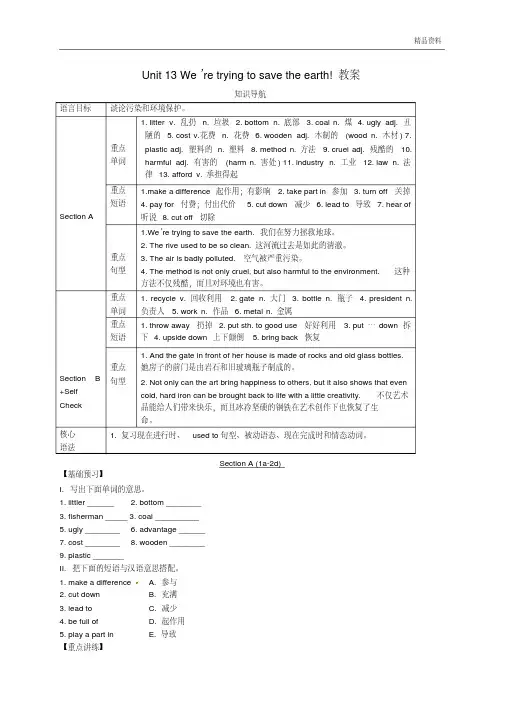
Unit 13 We’re trying to save the earth!教案知识导航语言目标谈论污染和环境保护。
Section A 重点单词1. litter v.乱扔n.垃圾2. bottom n.底部3. coal n.煤4. ugly adj.丑陋的 5. cost v.花费n.花费 6. wooden adj.木制的(wood n.木材) 7.plastic adj.塑料的n.塑料8. method n.方法9. cruel adj.残酷的10.harmful adj.有害的(harm n.害处) 11. industry n.工业12. law n.法律13. afford v.承担得起重点短语1.make a difference 起作用;有影响2. take part in 参加3. turn off 关掉4. pay for 付费;付出代价5. cut down 减少6. lead to 导致7. hear of听说8. cut off 切除重点句型1.We’re trying to save the earth. 我们在努力拯救地球。
2. The rive used to be so clean. 这河流过去是如此的清澈。
3. The air is badly polluted. 空气被严重污染。
4. The method is not only cruel, but also harmful to the environment. 这种方法不仅残酷,而且对环境也有害。
Section B +Self Check 重点单词1. recycle v.回收利用2. gate n.大门3. bottle n.瓶子4. president n.负责人 5. work n.作品 6. metal n.金属重点短语1. throw away 扔掉2. put sth. to good use 好好利用3. put … down 拆下 4. upside down 上下颠倒 5. bring back 恢复重点句型1. And the gate in front of her house is made of rocks and old glass bottles.她房子的前门是由岩石和旧玻璃瓶子制成的。
人教版九年级英语下册Unit 13 We’re trying to save the earth!教
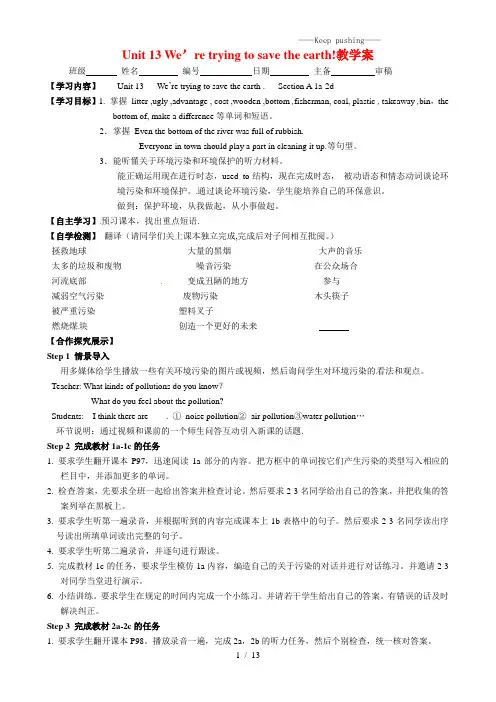
Unit 13 We’re trying to save the earth!教学案班级姓名编号日期主备审稿________【学习内容】Unit 13 We’re trying to save the earth . Section A 1a-2d【学习目标】1. 掌握litter ,ugly ,advantage , cost ,wooden ,bottom ,fisherman, coal, plastic , takeaway ,bin,the bottom of, make a difference等单词和短语。
2.掌握Even the bottom of the river was full of rubbish.Everyone in town should play a part in cleaning it up.等句型。
3.能听懂关于环境污染和环境保护的听力材料。
能正确运用现在进行时态,used to结构,现在完成时态,被动语态和情态动词谈论环境污染和环境保护。
通过谈论环境污染,学生能培养自己的环保意识。
做到:保护环境,从我做起,从小事做起。
【自主学习】预习课本,找出重点短语.【自学检测】翻译(请同学们关上课本独立完成,完成后对子间相互批阅。
)拯救地球__________________ 大量的黑烟__________________ 大声的音乐__________________ 太多的垃圾和废物_________________噪音污染__________________ 在公众场合__________________河流底部__________________ 变成丑陋的地方________________ 参与__________________减弱空气污染__________________废物污染__________________ 木头筷子__________________被严重污染__________________塑料叉子__________________燃烧煤块__________________创造一个更好的未来______________【合作探究展示】Step 1 情景导入用多媒体给学生播放一些有关环境污染的图片或视频,然后询问学生对环境污染的看法和观点。
人教版英语九年级全册Unit13We’retryingtosavetheearth!大单元教学设计
3.通过讨论,教师引入本单元的主题:“We’re trying to save the earth!”(我们正在尝试拯救地球),并简要介绍本节课的学习目标。
6.拓展延伸:鼓励学生在课后进行环保主题的研究,如调查身边的环保行为、采访环保人士等,将学习延伸到课堂之外。
四、教学内容与过程
(一)导入新课
在这一阶段,教师将采用多媒体资源和生活实例来导入新课,激发学生的学习兴趣和参与热情。
1.教师展示一系列关于地球环境问题的图片和视频,如森林砍伐、海洋污染、空气污染等,引导学生关注这些问题的严重性。
教学设想:通过词汇卡片、小组竞赛、情景剧等形式,让学生在实际语境中反复练习,加深记忆。
2.语法运用:现在进行时在描述正在进行的环保活动中的应用,以及一般现在时在陈述环保事实和习惯中的应用。
教学设想:设计语法练习,如填空、改错、句型转换等,帮助学生掌握语法规则,并通过真实的语境任务进行巩固。
3.阅读理解:提取文章主旨,理解作者观点,分析环保问题的原因和解决方案。
4.写作任务:请学生撰写一篇关于“我如何为地球环境保护做贡献”的短文,要求他们运用课堂所学的写作技巧,表达自己的观点和建议。
5.环保实践:鼓励学生在家中或学校进行一项环保实践活动,如回收废旧物品、节约用水用电等,并记录下来,在下一节课与同学分享。
6.家庭作业:布置一份综合性的家庭作业,结合本单元所学内容,要求学生观察并记录身边的环保行为,采访家人或朋友对环保的看法,整理成一篇小报告。
在教学过程中,教师应充分了解学生的学情,结合他们的需求和兴趣,设计有针对性的教学活动,激发学生的学习兴趣,提高他们的英语素养和环保意识。
人教版英语九年级全册Unit13Wearetryingtosavetheearth课教学设计
-通过问答、角色扮演等互动方式,巩固所学知识。
(三)学生小组讨论
1.教学活动设计:
-将学生分成小组,针对某一环境问题进行讨论,如空气污染、水污染等;
-小组成员分别扮演不同角色,如环保专家、政府官员、市民等,提出解决问题的建议;
-各小组汇报讨论成果,其他小组进行评价和补充。
-采用个别辅导和小组合作相结合的方式,关注学生的个体差异;
-及时反馈学生的练习情况,针对性地进行指导;
-鼓励学生积极参与,提高课堂练习的效果。
(五)总结归纳
1.教学活动设计:
-教师与学生一起回顾本节课所学的主要知识点;
-学生分享自己的学习心得和感悟;
-教师强调环保意识的重要性,并提出课后实践任务。
2.教学目标:
1.增强环保意识,认识到保护地球的重要性;
2.培养关爱自然、珍惜资源的情感;
3.树立可持续发展观念,养成节约能源、减少污染的良好习惯;
4.增进对国际合作解决环境问题的认识,提高社会责任感;
5.培养团队合作精神,学会倾听他人意见,尊重不同观点。
二、学情分析
针对九年级学生,他们在英语学习方面已具备一定的语言基础,但在环保主题的语境中,仍需加强相关词汇和表达方式的学习。此外,学生在面对现实环境问题时,可能缺乏关注和思考。因此,在教学过程中,应注重以下几点:
2.任务型教学法:设计小组任务,让学生在完成任务的过程中,掌握语言知识;
3.交际教学法:鼓励学生积极参与课堂讨论,提高口语表达能力;
4.互动式教学法:利用多媒体资源,组织学生进行角色扮演、小组讨论等活动,激发学生的学习兴趣;
5.自主学习:培养学生自主查找资料、整理信息的能力,提高学习效率。
《Unit 13 We are trying to save the earth!》教案
Unit 13 Were trying to save the earth!Period 3一、教学目标:Language aims:1.Key words:shark,fin,cruel,harmful,chain,ecosystem,industry,law,scientific2.Key phases:be harmful to,at the top of,the food chain,so far, not only… but also…3.Sentence pattern:Many have heard of shark fin soupThis is not only cruel, but also harmful to the environment.The numbers of some kinds of sharks have fallen by over 90 percent in the last 20 to 30 yearsEmotion aim: learn how to protect animals in danger二、学情分析本课内容是关于充满神秘感的海洋生物——鲨鱼的,所以学生很感兴趣。
三、重点短语及句型短语:be harmful to,at the top of,the food chain,so far, not only… but also…句型:Many have heard of shark fin soupThis is not only cruel, but also harmful to the environment.The numbers of some kinds of sharks have fallen by over 90 percent in the last 20 to 30 years教学过程:Step1Lead inTeacher: There are many kinds of pollution in our daily life. They are not only seen on the land, but also in the ocean. In the deep sea, there’re many kinds of creatures, but some of them are in danger.意图:把话题引入神秘的海洋,过渡自然,引起学生的兴趣。
人教版英语九年级全册unit13We’retryingtosavetheearth
设计意图:通过图片展示,让学生直观地感受到环境问题的严重性,为新课的学习做好情感铺垫。
2.教学活动:教师引导学生讨论以下问题:What do you see in these pictures? How do you feel about it? Do you think it's important to protect the environment?
2.培养学生的团队合作精神,使他们学会在合作中共同解决问题。
3.增强学生的社会责任感,让他们明白学习英语的目的之一是为了更好地参与国际交流,为全球环保事业做出贡献。
4.激发学生对英语学习的兴趣,帮助他们树立自信心,勇于面对挑战。
二、学情分析
针对人教版英语九年级全册Unit 13 “We’re trying to save the earth”的教学内容,学情分析如下:
人教版英语九年级全册unit13We’retryingtosavet
在本章节中,我们将围绕人教版英语九年级全册Unit 13 “We’re trying to save the earth”的主题,帮助学生掌握以下知识与技能:
1.掌握本单元的核心词汇和短语,如“pollution”, “waste”, “recycle”, “renewable energy”等,并能运用到日常交流中。
设计意图:激发学生的创作兴趣,提高他们的审美和动手能力。
设计意图:锻炼学生的书面表达能力,使他们能够运用所学知识阐述自己的观点。
2.口语作业:学生以小组为单位,录制一段关于环保的对话或访谈,讨论如何在学校或家庭中实施环保措施。要求每个成员都有发言机会,对话中需包含本节课所学的词汇和时态。
- 1、下载文档前请自行甄别文档内容的完整性,平台不提供额外的编辑、内容补充、找答案等附加服务。
- 2、"仅部分预览"的文档,不可在线预览部分如存在完整性等问题,可反馈申请退款(可完整预览的文档不适用该条件!)。
- 3、如文档侵犯您的权益,请联系客服反馈,我们会尽快为您处理(人工客服工作时间:9:00-18:30)。
Unit 13 We’re trying to save the earth!
一、教学目标:
1. 语言知识目标
基本词汇:litter, advantage, bottom, fisherman, coal, ugly, cost, wooden, plastic, takeaway, bin, shark, fin, method, cruel. Harmful, chain, ecosystem,
industry, law, scientific, afford, reusable, transportation, recycle,
napkin, upside, gate, bottle, president, inspiration, iron, work, metal,
creativity,
基本词组:be harmful to, at the top(of sth.), take part in, turn off, take action, throw away, put sth. to good use, pull… down, bring back
基本句型:We’re trying to save the earth!
The river used to be so clean.
The air is badly polluted.
No scientific studies have showed that shark fins are good for health.
We should help save the sharks.
2. 技能目标: 能正确运用现在进行时,现在完成时,被动语态,情态动词和used
to 句型。
3. 情感目标:有环境危机意识,学会关注环境保护环境。
二、教学重难点:
1. 教学重点:(1)能正确运用现在进行时,现在完成时,被动语态,情态动词
和used to 句型。
(2)保护环境的措施方法。
2. 教学难点:能正确运用现在进行时,现在完成时,被动语态,情态动词和used
to 句型。
三、教学步骤:
Section A 1 (1a-2d)
I. Presentation
Show the picture of the earth and tell students the earth is polluted now.
For example: (1) The factories that burn coal pollute the air with a lot of black smoke.
(2) Factories put waste into the river.。
